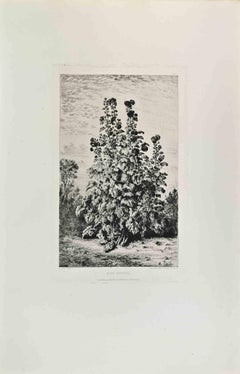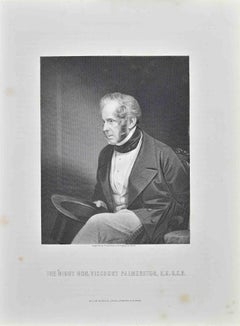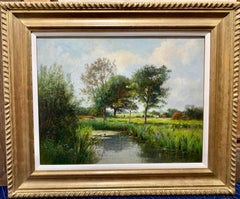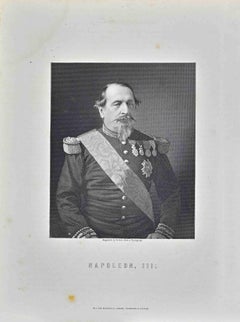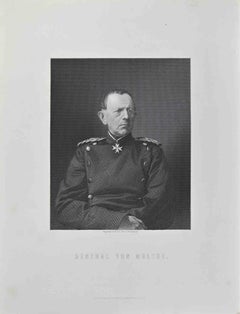1870s Art
to
88
1,193
296
92
45
43
Overall Width
to
Overall Height
to
7,552
21,062
160,143
233,391
1,940
2,228
4,772
6,401
5,821
14,945
20,288
25,533
17,790
13,650
5,340
979
126
59
2
2
1
1
1
1,023
601
5
667
368
358
341
336
293
267
177
173
169
145
89
86
65
65
63
58
56
50
50
515
412
329
303
211
39
13
11
9
8
288
1,117
976
411
Period: 1870s
Le Petit Troupeau - Etching by Jean-Ferdinand Chaigneau - 1870s
Located in Roma, IT
Le Petit Troupeau is a black and white etching realized by Jean-Ferdinand Chaigneau (1830-1906) in 1870s.
Titled in the lower.
Image size: 23.5x18cm.
Very Good condition.
Realize...
Category
Modern 1870s Art
Materials
Etching
Rose Trémière - Etching by Alfred Taiée - 1870s
Located in Roma, IT
Rose Trémière is an artwork realized by Alfred Taiée in the 1870s.
Etching.
Good conditions.
Realized for the "Société des Aquafortistes. Born on the initiative of the publisher...
Category
Modern 1870s Art
Materials
Etching
Portrait of the Right Hon.Viscount ... - Lithograph by William Holl - 1872
Located in Roma, IT
Portrait of the Right Hon. Viscount Palmerston, K.G. G.C.B. is an artwork realized by William Holl (1807-1871), from a Photograph by Mayall.
Lithograph, printed in 1872 by Milliam M...
Category
Art Nouveau 1870s Art
Materials
Lithograph
Victorian English 19th century Summer River with horses in a landscape
Located in Woodbury, CT
Wonderful English Victorian River Landscape during the Summer with horses, fields , trees etc
Thomas O Hume was an English landscape painter who exhibit...
Category
Victorian 1870s Art
Materials
Oil, Wood Panel
$3,000 Sale Price
20% Off
Portrait of Napoleon III - Lithograph by William Holl - 1872
Located in Roma, IT
Portrait of Napoleon III is anartwork realized by William Holl (1807-1871) from a photograph.
Lithograph, printed in 1872 by Milliam Mackenzie, London.
Good condition.
Category
Art Nouveau 1870s Art
Materials
Lithograph
Portrait of General Von Moltke - Lithograph by William Holl - 1872
Located in Roma, IT
Portrait of General Von Moltke is an artwork realized by William Holl (1807-1871), from a Photograph.
Lithograph, printed in 1872 by Milliam Mackenzie, London.
Good condition.
Category
Modern 1870s Art
Materials
Lithograph
Rome, Arch of Titus - Etching on Cardboard by Luca Beltrami - 1878
Located in Roma, IT
Rome, Arch of Titus is an original Modern artwork realized by Luca Beltrami (1854 - 1933) in 1878.
Original Sepia Etching on ivory cardboard.
Excelle...
Category
1870s Art
Materials
Cardboard, Etching
Ayant Couru à Chantilly - Etching by Jacques-Joseph Lecurieux - 1870s
Located in Roma, IT
Ayant Couru à Chantilly is an artwork realized by Jacques-Joseph Lecurieux in the 1870s.
Etching.
Good conditions.
Realized for the "Société des Aquafortistes. Born on the init...
Category
Modern 1870s Art
Materials
Etching
Rade De New-York - Etching by Anatole De Bonsonge - 1870s
Located in Roma, IT
Rade De New-York is an artwork realized by Anatole De Bonsonge in the 1870s.
Etching.
Good conditions.
Realized for the "Société des Aquafortistes. Born on the initiative of the p...
Category
Modern 1870s Art
Materials
Etching
“Seaside Cliffs, California”
Located in Southampton, NY
Beautiful original pastel on archival card stock from Paris of the craggy seaside cliffs of California by the well known Hudson River artist, George Douglas Bremerton. Signed lower left. Circa 1880. Condition is excellent. Under glass. The artwork is housed in its original ornate scroll designed frame. Overall framed measurements are 33 by 19 inches. Provenance: A East Coast Florida estate.
George Douglas Brewerton received lessons in art from Prof. Robert W. Weir at West Point where his father was Superintendent. In 1874, he was detailed to San Francisco as an officer in the Stevenson Regiment. In 1848, he underwent many adventures in Western deserts and mountains with Kit Carson, who crossed the country with news of the California Gold Rush. After serving as an aide to Gen. Rufus Saxton during the Civil War, Brewerton called himself “Colonel,” although he never received an army commission...
Category
Hudson River School 1870s Art
Materials
Pastel, Archival Paper
$2,240 Sale Price
20% Off
Au Fil de l'Eau - Etching by Aufray - 1870s
Located in Roma, IT
Au Fil de l'Eau is an artwork realized by Aufray in the 1870s.
Etching.
Good conditions.
Realized for the "Société des Aquafortistes. Born on the initiative of the publisher Alf...
Category
Modern 1870s Art
Materials
Etching
The Orchids - Lithograph by Vincenzo Tenore - 1870s
Located in Roma, IT
Lithograph hand watercolored.
Plate from "Atlante di Botanica popolare ossia Illustrazione di Piante Notevoli di ogni famiglia" (Atlas of popular botany or illustration of notable p...
Category
Modern 1870s Art
Materials
Lithograph
Camp de Chalons - Etching by Amédée de Boret - 1870s
Located in Roma, IT
Camp de Chalons is a black and white etching realized by Amédée de Boret (1837-1916) in 1870s.
Titled in the lower.
Image size: 29cmx20cm.
Very Good condition.
Realized by Cadart...
Category
Modern 1870s Art
Materials
Etching
Lichens - Lithograph by Vincenzo Tenore - 1870s
Located in Roma, IT
Lithograph hand watercolored.
Belongs to the Series "Atlante di Botanica popolare ossia Illustrazione di Piante Notevoli di ogni famiglia" (Atlas of popular botany or illustration o...
Category
Modern 1870s Art
Materials
Lithograph
Bouquet of chrysanthemums
Located in Genève, GE
Work on canvas
Category
1870s Art
Materials
Oil
Salcio Caprino - Lithograph by Vincenzo Tenore - 1870s
Located in Roma, IT
Lithograph hand watercolored.
Belongs to the Series "Atlante di Botanica popolare ossia Illustrazione di Piante Notevoli di ogni famiglia" (Atlas of popular botany or illustration o...
Category
Modern 1870s Art
Materials
Lithograph
Long-Leaf Pachira - Lithograph by Vincenzo Tenore - 1870s
Located in Roma, IT
Lithograph hand watercolored.
Belongs to the Series "Atlante di Botanica popolare ossia Illustrazione di Piante Notevoli di ogni famiglia" (Atlas of popular botany or illustration o...
Category
Modern 1870s Art
Materials
Lithograph
Mendiant Romain - Etching by Joseph Soumy - 1870s
Located in Roma, IT
Mendiant Romain is an artwork realized by Soumy in the 1870s.
Etching.
Good conditions.
Realized for the "Société des Aquafortistes. Born on the initiative of the publisher Alfred...
Category
Modern 1870s Art
Materials
Etching
Geraniaceae - Lithograph by Vincenzo Tenore - 1870s
Located in Roma, IT
Lithograph hand watercolored.
Belongs to the Series "Atlante di Botanica popolare ossia Illustrazione di Piante Notevoli di ogni famiglia" (Atlas of popular botany or illustration o...
Category
Modern 1870s Art
Materials
Lithograph
A Cadart & Luquet - Etching by Edouard Dufeu - 1870s
Located in Roma, IT
A Cadart & Luquet is an artwork realized by Edouard Dufeu in the 1870s.
Etching.
Good conditions.
Realized for the "Société des Aquafortistes. Born on the initiative of the publ...
Category
Modern 1870s Art
Materials
Etching
Citino Hypocystis - Lithograph by Vincenzo Tenore - 1870s
Located in Roma, IT
Lithograph hand watercolored.
Belongs to the Series "Atlante di Botanica popolare ossia Illustrazione di Piante Notevoli di ogni famiglia" (Atlas of popular botany or illustration o...
Category
Modern 1870s Art
Materials
Lithograph
The Chenopodiaceae - Lithograph by Vincenzo Tenore - 1870s
Located in Roma, IT
Lithograph hand watercolored.
Plate from "Atlante di Botanica popolare ossia Illustrazione di Piante Notevoli di ogni famiglia" (Atlas of popular botany or illustration of notable p...
Category
Modern 1870s Art
Materials
Lithograph
The Alismaceae - Lithograph by Vincenzo Tenore - 1870s
Located in Roma, IT
Lithograph hand watercolored.
Plate from "Atlante di Botanica popolare ossia Illustrazione di Piante Notevoli di ogni famiglia" (Atlas of popular botany or illustration of notable p...
Category
Modern 1870s Art
Materials
Lithograph
Garofalo Vergato - Lithograph by Vincenzo Tenore - 1870s
Located in Roma, IT
Lithograph hand watercolored.
Belongs to the Series "Atlante di Botanica popolare ossia Illustrazione di Piante Notevoli di ogni famiglia" (Atlas of popular botany or illustration o...
Category
Modern 1870s Art
Materials
Lithograph
The Cucurbitaceae - Lithograph by Vincenzo Tenore - 1870s
Located in Roma, IT
Lithograph hand watercolored.
Plate from "Atlante di Botanica popolare ossia Illustrazione di Piante Notevoli di ogni famiglia" (Atlas of popular botany or illustration of notable p...
Category
Modern 1870s Art
Materials
Lithograph
Model - Etching by G. De Nittis - 1870s
Located in Roma, IT
Charming original drypoint on ivorycoloured plate realized by Giuseppe De Nittis between 1870 and 1880. Signed on plate lower left margin, not numbered and in perfect conditions. Inc...
Category
Modern 1870s Art
Materials
Drypoint, Etching
The Georgian - Lithograph by Vincenzo Tenore - 1870s
Located in Roma, IT
Lithograph hand watercolored.
Plate from "Atlante di Botanica popolare ossia Illustrazione di Piante Notevoli di ogni famiglia" (Atlas of popular botany or illustration of notable p...
Category
Modern 1870s Art
Materials
Lithograph
Bords du Sornin - Etching by Armand Charnay - 1860s
Located in Roma, IT
Bords du Sornin is an artwork realized by A.Charnay in the 1870s.
Etching.
Image size:19x29
Good conditions.
Realized for the "Société des Aquafortistes. Born on the initiative...
Category
Modern 1870s Art
Materials
Etching
Pardon Breton - Etching by Otto Weber - 1870s
Located in Roma, IT
Pardon Breton is a black and white etching realized by Otto Weber (1832-1888) in 1870s.
Titled in the lower.
Image size: 24cmx18cm.
Good condition.
Signed on the lower left.
Re...
Category
Modern 1870s Art
Materials
Etching
Hope - Original etching - Ed. Durand Ruel, 1873
Located in Paris, IDF
Pierre PUVIS DE CHAVANNES (after)
Hope, 1873
Original Etching
Engraved by Boilvin under the supervision of PUVIS DE CHAVANNES
Printed signature in the plate
On laid paper 20,5 x 30 cm (c. 8 x 12 in)
INFORMATION : This etchings was edited in 1873 by Galerie Durand Ruel...
Category
Impressionist 1870s Art
Materials
Etching
“Returning Home”
By Hermanus Jan Hendrik Rijkelijkhuysen
Located in Southampton, NY
Original etching on Ingres laid paper (watermarked, see last photograph) attributed to the hand of the well known Dutch artist, Hermanus Jan Hendrik Rijkelijkhuysen. No visible signature. Sheet size 9.25 by 12 inches. Sight size 7 by 9 inches. Under glass. Circa 1875. Condition is excellent. Professionally matted and framed in a walnut colored frame with gold leaf edge. Overall framed measurements are 12.75 by 14.5 inches. Gallery label verso. Provenance: A Sarasota, Florida collector.
Biography:
Hermanus Jan Hendrik Rijkelijkhuysen (1813-1883) was a landscape painter and etcher. Rijkelijkhuysen spent most of his life working in the vicinity of his birthplace Utrecht. Inspired by the polders on the one hand and the Utrechtse Heuvelrug on the other, he mainly painted and etched water...
Category
Academic 1870s Art
Materials
Laid Paper, Etching
$520 Sale Price
20% Off
Organography - Lithograph by Vincenzo Tenore - 1870s
Located in Roma, IT
Lithograph.
Belongs to the Series "Atlante di Botanica popolare ossia Illustrazione di Piante Notevoli di ogni famiglia" (Atlas of popular botany or illustration of notable plants o...
Category
Modern 1870s Art
Materials
Lithograph
Basse Cour - Etching by Eugène Cottin - 1870s
Located in Roma, IT
Basse Cour is a black and white etching realized by Eugène Cottin (1840-1902) in 1870s.
Titled in the lower.
Image size: 22.5cmx10.5cm.
Very Good condition.
Realized by Cadart fo...
Category
Modern 1870s Art
Materials
Etching
En Italie - Etching by Giberto Borroméo - 1870s
Located in Roma, IT
En Italie is an artwork realized by Giberto Borroméo in the 1870s.
Etching.
Good conditions.
Realized for the "Société des Aquafortistes. Born on the initiative of the publisher...
Category
Modern 1870s Art
Materials
Etching
The Labbiate - Lithograph by Vincenzo Tenore - 1870s
Located in Roma, IT
Lithograph hand watercolored.
Plate from "Atlante di Botanica popolare ossia Illustrazione di Piante Notevoli di ogni famiglia" (Atlas of popular botany or illustration of notable p...
Category
Modern 1870s Art
Materials
Lithograph
The Entree - Lithograph by Vincenzo Tenore - 1870s
Located in Roma, IT
Lithograph hand watercolored.
Plate from "Atlante di Botanica popolare ossia Illustrazione di Piante Notevoli di ogni famiglia" (Atlas of popular botany or illustration of notable p...
Category
Modern 1870s Art
Materials
Lithograph
Le Bain - Etching by Charles Chaplin - 1870s
Located in Roma, IT
Le Bain is an artwork realized by Charles Chaplin in the 1870s.
Etching.
Image size:23x13
Good conditions.
Realized for the "Société des Aquafortistes. Born on the initiative o...
Category
Modern 1870s Art
Materials
Etching
Oil Sketch From Rome Called Ruins of Ancient Rome, c. 1870-72
Located in Stockholm, SE
This beautiful oil sketch, painted en plein air, was created by Swedish artist Olof Arborelius during his stay in Italy from the fall of 1870 until January 1872. The painting features a charming depiction of ancient Roman ruins—either a city wall or an aqueduct—surrounded by lush trees under the clear Italian sky. With loose brushstrokes and a soft, atmospheric touch, the artist captures the natural light and Mediterranean ambiance, demonstrating his profound understanding of plein air painting.
Arborelius was heavily influenced by French artistic trends of the time, particularly in his color sensitivity and study of light and air. His time in Italy was critical for his artistic development, marking the height of his mastery in capturing the delicate interplay of light, color, and atmosphere.
Several of Arborelius’ Italian oil studies, including similar small-format plein air works, were later exhibited at various prestigious exhibitions. These include the Svenska konstnärernas förening memorial exhibition in 1910, the Svensk-Franska Konstgalleriet in Stockholm in 1931, and a memorial exhibition at the Nationalmuseum in 1943.
Viggo Loos praised Arborelius' Italian studies for their "sensitivity to color" and "intense exploration of light and atmosphere," highlighting these works as a high point in the artist's career. Loos emphasized how Arborelius skillfully captured the essence of the Mediterranean landscape, using vibrant tones and delicate brushwork to convey the interplay of light and air.
Moreover, Folke Holmér, the curator of Arborelius’ 1943 memorial exhibition, described his Italian sketches as some of the most painterly pieces of his early production, worthy of comparison with the best works Swedish artists had produced in Italy.
Among his notable works in major collections are three of his Italian oil studies held at the Nationalmuseum: View from Rome Towards the Arch of Septimius Severus...
Category
Impressionist 1870s Art
Materials
Paper, Oil, Cardboard
Un Marèchal à Moret - Etching by Jules Jacques Veyrassat - 1870s
Located in Roma, IT
Un Marèchal à Moret is a black and white etching realized by Jules Jacques Veyrassat (1828-1893) in 1870s.
Titled in the lower.
Image size: 27cmx19cm.
Good condition.
Signed on t...
Category
Modern 1870s Art
Materials
Etching
Bluebreast - Woodcut Print by Alexander Francis Lydon - 1870
Located in Roma, IT
Bluebreast is a modern artwork realized in 1870 by the British artist Alexander Francis Lydon (1836-1917) .
Woodcut print, hand colored, published by London, Bell & Sons, 1870. Na...
Category
Modern 1870s Art
Materials
Woodcut
Late 19th Century Engraving -- "A Hot Bargain" Painting by Frederick Bridgman
Located in Soquel, CA
Beautiful engraving of a late 19th Century painting by Frederic Arthur Bridgman (American, 1847 - 1928) titled "A Hot Bargain," (see image) engraved by James D. Smillie (American, 1833-1909), circa 1900. Signed lower right edge. Edition 64/225 with attribution to piece and artist on verso. Presented in with new mat. Original mat on verso. Condition: Good, minor foxing on edge. Image size: 5.88"H x 9"W.
A native of New York and the son of an engraver, James David Smillie earned his early reputation for his etching skills but later for watercolor landscapes. He began etching at age 8, learning from his father, James Smillie...
Category
Realist 1870s Art
Materials
Paper, Ink
A Nohant-Vico - Etching by Joseph François Villevieille - 1870s
Located in Roma, IT
A Nohant-Vico is an artwork realized by Joseph François Villevieille in the 1870s.
Etching.
Good conditions.
Realized for the "Société des Aquafortistes. Born on the initiative of...
Category
Modern 1870s Art
Materials
Etching
A Lying Animal - Original Lithograph by F. Specht - 1880
Located in Roma, IT
A Lying Animal is a black and white print realized by Friedrich Specht in 1880.
Lithograph on dark paper. Original Title: Derendet.
Dated 1880, p.24. Signed by the artist on the r...
Category
Naturalistic 1870s Art
Materials
Lithograph
The Whitebeam - Lithograph by Vincenzo Tenore - 1870s
Located in Roma, IT
Lithograph hand watercolored.
Plate from "Atlante di Botanica popolare ossia Illustrazione di Piante Notevoli di ogni famiglia" (Atlas of popular botany or illustration of notable p...
Category
Modern 1870s Art
Materials
Lithograph
French Watercolor and Pencil Drawing - Family Countryside Scene
Located in Houston, TX
French watercolor and pencil drawing from 1873, likely depicting a father, his two young sons, and their goat relaxedly coexisting in a quiet buc...
Category
1870s Art
Materials
Paper, Watercolor, Pencil
Hotel du Figaro - Original Lithograph by Cesar Daly - 1877
Located in Roma, IT
Hotel du Figaro is a modern artwork realized in 1877 by Cesar Daly.
Mixed colored lithograph.
The artwork is the Plate 16 of 'L'Architecture Privee au XIX...
Category
Modern 1870s Art
Materials
Lithograph
The Bromeliads - Lithograph by Vincenzo Tenore - 1870s
Located in Roma, IT
Lithograph hand watercolored.
Plate from "Atlante di Botanica popolare ossia Illustrazione di Piante Notevoli di ogni famiglia" (Atlas of popular botany or illustration of notable p...
Category
Modern 1870s Art
Materials
Lithograph
The Cruciferous - Lithograph by Vincenzo Tenore - 1870s
Located in Roma, IT
Lithograph hand watercolored.
Plate from "Atlante di Botanica popolare ossia Illustrazione di Piante Notevoli di ogni famiglia" (Atlas of popular botany or illustration of notable p...
Category
Modern 1870s Art
Materials
Lithograph
The Elm - Lithograph by Vincenzo Tenore - 1870s
Located in Roma, IT
Lithograph hand watercolored.
Plate from "Atlante di Botanica popolare ossia Illustrazione di Piante Notevoli di ogni famiglia" (Atlas of popular botany or illustration of notable p...
Category
Modern 1870s Art
Materials
Lithograph
Rue des Arènes - Etching by Armand Queyroy - 1870s
Located in Roma, IT
Rue des Arènes is a black and white etching realized by Armand Queyroy (1830-1893) in 1870s.
Titled in the lower.
Image size: 20cmx29cm.
Very Good condition.
Signed on the upper ...
Category
Modern 1870s Art
Materials
Etching
Organography - Lithograph by Vincenzo Tenore - 1870s
Located in Roma, IT
Lithograph.
Belongs to the Series "Atlante di Botanica popolare ossia Illustrazione di Piante Notevoli di ogni famiglia" (Atlas of popular botany or illustration of notable plants o...
Category
Modern 1870s Art
Materials
Lithograph
The Napoleonee - Lithograph by Vincenzo Tenore - 1870s
Located in Roma, IT
Lithograph hand watercolored.
Plate from "Atlante di Botanica popolare ossia Illustrazione di Piante Notevoli di ogni famiglia" (Atlas of popular botany or illustration of notable p...
Category
Modern 1870s Art
Materials
Lithograph
Le Val Clémence - Etching by T.Abraham - 1870s
Located in Roma, IT
Le Val Clémence is an artwork realized by T.Abraham in the 1870s.
Etching.
Good conditions.
Realized for the "Société des Aquafortistes. Born on the initiative of the publisher ...
Category
Modern 1870s Art
Materials
Etching
The Buttercup - Lithograph by Vincenzo Tenore - 1870s
Located in Roma, IT
Lithograph hand watercolored.
Plate from "Atlante di Botanica popolare ossia Illustrazione di Piante Notevoli di ogni famiglia" (Atlas of popular botany or illustration of notable p...
Category
Modern 1870s Art
Materials
Lithograph
The Star Anise - Lithograph by Vincenzo Tenore - 1870s
Located in Roma, IT
Lithograph hand watercolored.
Plate from "Atlante di Botanica popolare ossia Illustrazione di Piante Notevoli di ogni famiglia" (Atlas of popular botany or illustration of notable p...
Category
Modern 1870s Art
Materials
Lithograph
The Gooseberry - Lithograph by Vincenzo Tenore - 1870s
Located in Roma, IT
Lithograph hand watercolored.
Plate from "Atlante di Botanica popolare ossia Illustrazione di Piante Notevoli di ogni famiglia" (Atlas of popular botany or illustration of notable p...
Category
Modern 1870s Art
Materials
Lithograph
Prisonnier - Etching by Armand Gautier - 1870s
Located in Roma, IT
Prisonnier is an artwork realized by A.Gautier in the 1870s.
Etching.
Good conditions.
Realized for the "Société des Aquafortistes. Born on the initiative of the publisher Alfre...
Category
Modern 1870s Art
Materials
Etching
Title Page of the Atlas of Popular Botany- Lithograph by Vincenzo Tenore - 1870s
Located in Roma, IT
Lithograph hand watercolored.
Plate from "Atlante di Botanica popolare ossia Illustrazione di Piante Notevoli di ogni famiglia" (Atlas of popular botany or illustration of notable p...
Category
Modern 1870s Art
Materials
Lithograph
Organography - Lithograph by Vincenzo Tenore - 1870s
Located in Roma, IT
Lithograph.
Plate from "Atlante di Botanica popolare ossia Illustrazione di Piante Notevoli di ogni famiglia" (Atlas of popular botany or illustration of notable plants of each fami...
Category
Modern 1870s Art
Materials
Lithograph
The Hyacinth - Lithograph by Vincenzo Tenore - 1870s
Located in Roma, IT
Lithograph hand watercolored.
Plate from "Atlante di Botanica popolare ossia Illustrazione di Piante Notevoli di ogni famiglia" (Atlas of popular botany or illustration of notable p...
Category
Modern 1870s Art
Materials
Lithograph

